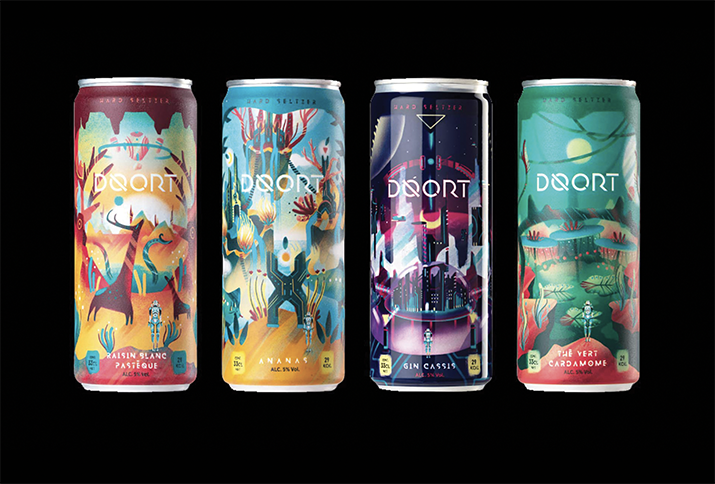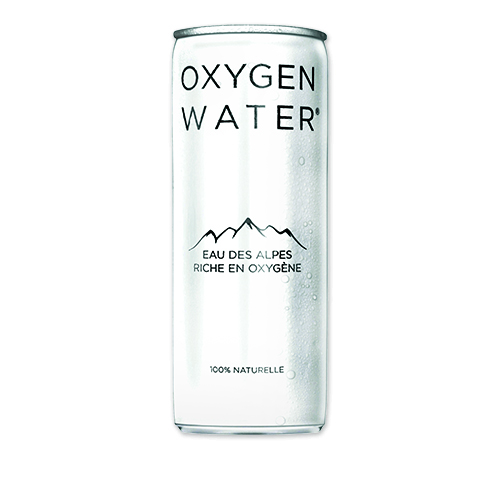French dispatch

Hard Seltzers are a growing craze in France. Image: La Boîte Boisson
The French can market shows ‘energetic growth’ despite Covid and the war in Ukraine, say experts. By Liz Newmark
he Covid-19 crisis has not stopped the dynamism of the drinks can market in France, where six billion cans are produced every year; indeed, it seems to have strengthened sales. More than two drinks out of 10 – 22.3 per cent – sold in French shops in 2021 were in cans, according to France’s drinks can industry association, La Boîte Boisson. When bars, cafés and restaurants reopened, cans still outperformed plastic bottles (+0.5 per cent) and glass (+3.3 per cent), with the 25cl can doing particularly well (+20.5 per cent), in food service sales.
“People are using more metal packaging,” La Boîte Boisson managing director Lucien Debever told CanTech International. “The can is growing strongly in all sectors, notably in markets where it was not very present beforehand, such as water, wine or speciality beer.”
In 2021, 90 per cent of sales of ‘hard seltzers,’ the new craze of carbonated water, alcohol and fruit juice drinks, “all the rage with young people,” were in cans, Debever said.
Citing figures announced by the organisation on 23 February, he pointed out that cans have performed well over the last two years. Sales have jumped 9.5 per cent in volume, outdoing the growth of the beer and soft drinks market (+6.5 per cent. “French factories have continued to produce and the can has revealed itself to be a part of the ‘pleasure’ products consumers turn to, that were kept on the shelves during the pandemic,” he said.
“The development in parallel of take-out and home deliveries has also encouraged the use of this perfect packaging for transport – unbreakable, stackable and in a compact form,” added Debever. La Boîte Boisson says the rise in can sales in France has been especially driven by the success of soft drinks cans, which continue to gain market share on other beverage packaging. From 2019 to 2021, their sales increased by 15 per cent in volume and the share of cans in soft drinks sales increased from 19.9 per cent to 21.9 per cent. “In 2021, can sales increased 7.3 per cent in volume compared to 2020,” said his association. Sales of canned energy drinks rose sharply by 25 per cent in 2021, while fruit juice cans also saw rapid growth of 16.7 per cent over 2020 figures. As a result of numerous brand innovations and product launches ‘flooding the shelves’, canned flavoured water sales increased 6 per cent and sparkling waters rose by 9 per cent compared to 2020.
For example, French beverage company’s Ogeu’s partnership with New York-listed Ardagh Metal Packaging in 2021 produced canned energy drinks Truc de Fou and Breizh Elixir, canned ice teas Thé Noir Pêche (peach-flavoured black tea) and Thé Vert Menthe (mint-favoured green tea) and 33cl Alqua Hard Seltzers in lemon/lime, mango/pineapple and raspberry flavours. With craft beers increasingly popular, beer supplier Neodif, based near Nantes, has partnered with Brasserie Duyck and Crown Bevcan Europe & Middle East to distribute artisanal beers from the American brewer Noble Rey in France.
Turning to alcoholic drinks can sales, overall market share dropped 0.3 per cent in 2021 compared to 2020 due to a fall in consumption of ‘luxury’ beers – where sales in all packaging dropped by 11.9 per cent, La Boîte Boisson said. But beer can sales exploded on non-alcoholic beers, with a +55 per cent volume growth between 2020 and 2021, and continue to grow from speciality beer (such as Abbey beers made in monasteries and all flavoured beers): +5.4 per cent growth between 2020 and 2021 and +7 per cent between 2019 and 2021.
Sales of drinks in cans also performed well in supermarkets and convenience stores, the organisation said, with robust growth in online sales sites (+11 per cent). Sales rose 6.6 per cent in convenience stores and 5.9 per cent in hypermarkets.

French consumers, increasingly aware of environmental concerns, are turning away
from plastic bottles.
Image: La Boîte Boisson
Packaging giants
According to Paris-based market research analysts Businesscoot, in a French metal packaging market report, the French metal packaging market is concentrated with Crown and Ardagh accounting for more than 60 per cent of sales.
Crown, for example, has a metal packaging plant in Custines, north-east France, which makes aluminium cans and tins for food and beverage products. Ardagh’s main metal packaging factory is in La Ciotat, southern France. Ardagh also has a 42 per cent share in Trivium Packaging which makes sustainable metal packaging for the food and drink, speciality and personal care markets. Trivium has nine plants in France, including in Roy, Ludres and Beaupaire. Ball is also an important player. Its French headquarters are in Bierne, northern France, which concentrates on aluminium cans. There is also Ball Beverage Packaging France with headquarters at Mont, Nouvelle Aquitaine.
Lucien Debever noted eight out of 10 cans consumed in France are made in French factories. France’s three metal packaging majors – Ball, Ardagh and Crown Bevcan – have entirely switched to aluminium: “The cans still found in steel are therefore imports,” he said.
He added that one big move this year is Coca-Cola’s investments in its filling lines at its largest factory in Bierne, near Dunkerque. On 10 March French newspaper La Voix du Nord reported that Coca-Cola European Partners has announced a EUR30 million investment in the new can production line for the Monster brand at the Socx-Bierne site. The line is already under construction and should be up and running next year.
Namrata Sharma, research associate at Euromonitor International, confirmed metal beverage cans saw retail growth in 2020 (5 per cent in 2019-2020) in France. “Cans performed better than glass bottles, seen as being heavier, more prone to breakage and less suitable for e-commerce – more prevalent due to Covid-19 lockdowns and other restrictions,” she said.
“Metal beverage cans for alcoholic drinks are expected to continue growing [in France], with a retail unit volume increase of 2.8 per cent over 2021-2025, thanks to cans being lighter, more compact and more portable than glass bottles.”
For food service packaging, French metal beverage cans sales (as elsewhere in Europe) should see a strong recovery in 2022, following “less foot traffic in bars and restaurants since Covid-19 and lingering safety concerns with regard to the spread of the virus. Bars and restaurants might not need the large pack sizes that kegs offer, but instead prefer pack types such as metal beverage cans that come in smaller pack sizes,” Sharma said.
Metal beverage cans for soft drinks lost ground during confinement, when French consumers wanted to stock their shelves with family-friendly solutions. “Sales of the 15cl metal beverage can format in juice drinks (up to 24 per cent juice) declined sharply in 2020 and 2021, although this was a trend visible prior to the pandemic, with this pack type close to disappearing from the French juice drinks market.”
However, Euromonitor said the French soft drinks packaging industry recovered sales in 2021 after the pandemic eased, when consumers spent longer periods of time outside. This benefited foodservice packaging like metal beverage cans – expected to see a France retail unit volume compound annual growth rate (CAGR) of 4.5 per cent over 2021-2025.
Meanwhile the Russian invasion of Ukraine, universally condemned by the industry, has not yet significantly impacted can sales in France, said Lucien Debever, He told CanTech International that international aluminium costs were already high before the war began – breaking records at more than USD3,000 per tonne. “Although Russia is not the leading aluminium producer, it remains an important production point,” he said.
International can makers who had factories in Russia, such as Ball, have stopped their activities, while continuing with planned major investments in the UK for example, much closer to the French market, he said.
As for prices, futures contracts at the London Metal Exchange (LME) stabilise and guarantee prices, so there are no short-term worries. “As for many sectors, the length of the conflict will be decisive,” said Debever.
Boosting aluminium’s reputation
Looking ahead, he said French consumers are giving greater importance to environmental criteria when choosing products and their packaging, while cost remains the biggest factor. “So, brands are turning increasingly to the can – for example craft beers that advocate the can as packaging that keeps the beer perfectly and is infinitely recyclable.”
And while France had been lagging in its development of aluminium packaging recycling – with French packaging recovery organisation Citeo announcing that the 2019 recycling rate for aluminium packaging from selective collection was 48 per cent – the French government and its manufacturing and waste industries have now set ambitious targets to improve this performance.
Notably Citeo’s ‘Project Metal’ launched in 2014 with the Association of Cities and Regions for Sustainable Resource Management (ACR+) to boost sorting rates of light aluminium in pilot sorting centres was extended in December 2017 for another four-year period (2018-2022). The initiative aims to ensure that 30 million citizens in France sort and recycle all their metal packaging by the end of 2022.
In addition, the last review of the European Union packaging and packaging waste directive (94/62/EC) in 2018 increased metal recycling targets, which are binding on France and other EU member states, and set individual goals for ferrous metals and aluminium. A new revision is scheduled to be proposed by the European Commission between July and October 2022. The original packaging directive set a joint 50 per cent recycling target for aluminium and ferrous metals. The new targets, by 2025 and 2030 respectively, are 50 per cent and 60 per cent for aluminium and 70 per cent and 80 per cent for steel.
In addition, associations European Aluminium and Metal Packaging Europe, of which La Boite Boisson is a member, are aiming for zero collection and sorting losses of aluminium by 2030.
The revision also includes a new calculation methodology where only input in a final recycling process is counted. “This harmonised methodology will help to ensure that member states only report what is really recycled, for each material,” said Alexis Van Maercke, secretary general of the Association of European Producers of Steel for Packaging (APEAL). “We will start to see this new methodology affecting data released this year, as it concerns 2020 data released in 2022.” Meanwhile, he said steel packaging, “one of the easiest materials to separate and the most economical to recycle, recorded an average recycling rate of 84 per cent across Europe in 2019, and the impact of the new methodology is expected to be limited.”
Finally, the French can sector has been aided by a new national law banning plastic packaging on fruit and vegetables from 1 January, which should encourage the use of cans, said Ms Sharma. She told CanTech International these developments will boost production and sales of metal beverage cans over 2021-2025.
This feature article is restricted to logged-in paid subscribers.
Login or subscribe now to view this exclusive content.



